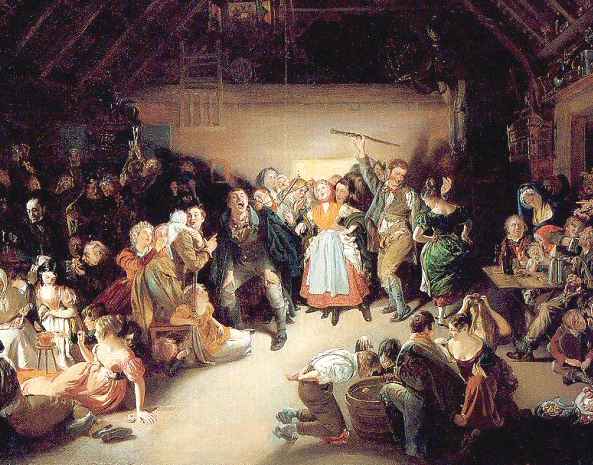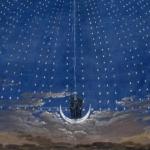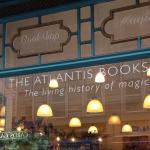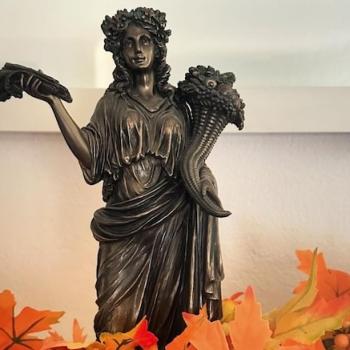Samhain practices don’t have to be elaborate or completely scripted. Many years ago when I was coven-less I used to celebrate Samhain simply with the lighting of a few candles to honor my beloved dead. As my practice has grown I’ve added new elements, traditions, and wrinkles, though most of my Samhain practices remain rather simple and easy to do.
My observance of Samhain is inspired by the ancient Irish-Celtic celebration of the holiday thousands of years ago (of which we know very little), and more modern interpretations of the day that have grown out of Halloween celebrations and other sources. There’s no one right or wrong way to celebrate Pagan Christmas, and what’s most important is picking practices that work for you!
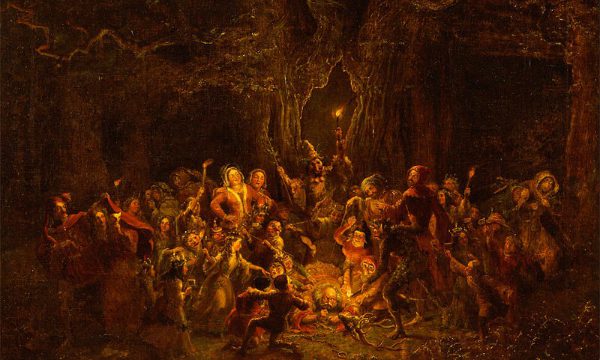
And Samhain is more than just one night, it’s a season. The veil is thin now and will still be thin into November. If you feel overwhelmed this Samhain remember that it can be celebrated over several nights and days. Whatever you do and however you do it, have a blessed holiday!
FEASTING
We aren’t sure exactly what happened when the ancient Irish-Celts gathered to celebrate (or cower in fear over) Samhain, but it seems likely that they probably feasted. Samhain-season was a time for culling the herds and taking in the last fruits of the harvest, which means there was probably a lot of fresh produce and meat around, and what better way to to get rid of it than with a little feasting? Besides, having a feast goes well with another Samhain activity . . . .
DUMB SUPPER
A dumb supper is a silent dinner with a full plate left out for those who have gone before us. It’s a chance to thank your ancestors and provide them with a hearty welcome into your home. Generally one plate is set aside for the dead (so you don’t have to serve Grandma and Grandpa and everyone else-they can share a space), and the entire meal is eaten in silence. If you’ve never participated in a dumb supper before it can be a bit unnerving, we talk a lot more than we think we do. It’s especially challenging if you are hosting several Witches all participating in the dumb supper.
When I finish with a dumb supper at my house I leave the physical leftovers outside, generally by the lemon tree in my backyard that we use as a spot for offerings. (IF you’ve got a small Samhain fire going in your backyard that’s another place you can leave the leftovers.) It’s considered bad luck to eat food given to the dead, so resist the urge to eat off of Grandma’s plate. While the food will look untouched, it’s the essence of the offering that the spirits consume, not the physical stuff, so don’t worry about your offering not being accepted, it most likely was!
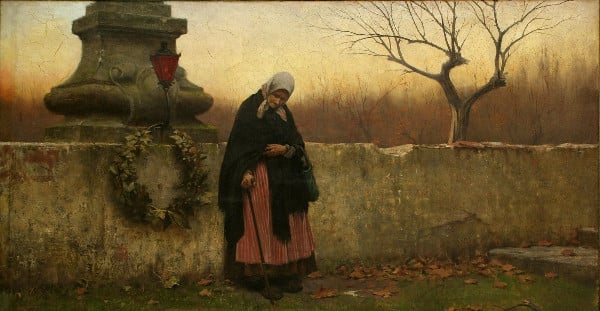
TALK TO THE DEAD
I reserve a good twenty minutes every Samhain to talk to my deceased Grandparents. I think about them most days, but I rarely speak to them. With the veil between the world’s at its thinnest I think Samhain presents a great opportunity to catch them up on my life and ask them how they are doing. At Samhain I talk to them like I did while they were alive and it’s cathartic and comforting to do so.
Don’t expect answers in the conventional sense, my Grandparents don’t make any reciprocal noises when I talk to them, but I do feel as if they respond. I feel them close to me, and often sense various emotions while I’m speaking to them. I’m convinced that they visit at Samhain, and it’s absolutely wonderful thing to experience.
BONFIRES
Our ancestors probably built large bonfires on Samhain. Part of that might have been to celebrate the feasting that was going on, but it was most likely done to keep the fey away. Our ancestors were quite scared of the fair-folk and believed that Samhain was an especially dangerous time of year for dealing with the fey.
Hopefully most of us have a better relationship with the fey than our ancestors and don’t need a fire to keep them away, but if you are worried about a few particularly malevolent forces this Samhain-season a fire might help. As for me I just like gathering around a fire and enjoying a cool Autumn night under the stars. I find that it connects me to the natural world, and if I listen and observe the world around me, other things too.
There’s also a more modern reason we often see bonfires in late October and early November-the English holiday known as Guy Fawkes Night or Bonfire Night. Giant bonfires were kindled on Guy Fawkes Night in many cities and villages, and this tradition was eventually rolled into some Halloween celebrations, especially in the United States.
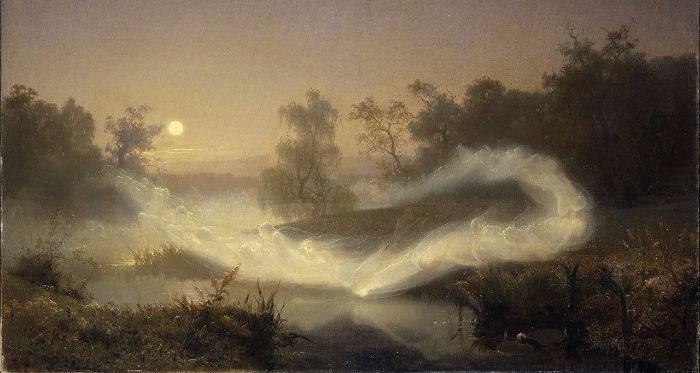
THANK THE GODDESSES AND GODS YOU HONOR
In many Contemporary Pagan traditions the sacrifice of The Horned God is celebrated at one of the three Harvest Festivals (Lughnassa, Autumn Equinox, and Samhain). It’s said that his sacrifice each year makes the land fertile and allows the crops to be harvested so we can survive the Winter. Now most of us don’t believe The God literally dies (he’s a deity after all), but it’s an effective myth for explaining the Wheel of the Year and honoring the transitions that take place in our own lives.
Because the God dies for to ensure the Earth’s bounty this is a great time of year to thank the Lord and Lady (and whatever specific deities you honor) for what they’ve given you in the past year. That might be as simple as good health, or perhaps that long overdue raise. The fact that we are all here and still breathing is sometimes reason enough to be thankful.
DIVINATION
We don’t think about divination on Halloween very much these days, but traditional games like bobbing for apples evolved from divination customs and techniques in Great Britain. It was said that slicing an apple at midnight on Halloween night in front of a mirror would reveal a future lover’s reflection. Another form of divination involved throwing nuts in a fire and looking for signs about future loves and even present day relationships.
In Robert Burns classic poem Halloween the Scottish poet references this custom:
The auld guidwife’s well-hoordit nits,
Are round and round divided,
And monie lads’ and lasses’ fates
Are there that night decided:
Some kindle coothie, side by side,
And burn thegither trimly;
Some start awa, wi’ saucy pride,
And jump out-owre the chimlie
Fu’ high that night.
Even if you don’t want to throw nuts in the fire or slice an apple, it’s still a good time to get out the tarot cards and reflect on what’s happened in the past year, and what may soon transpire. I’ve always believed that the energy of the thinning veil makes divination just a little bit easier this time of year.
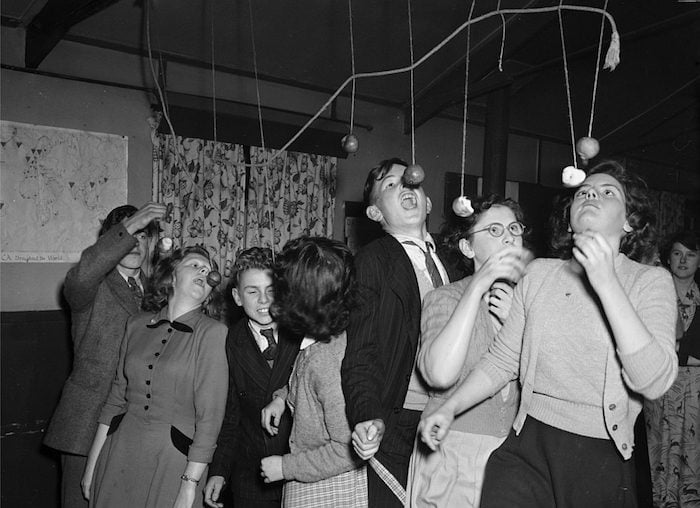
SAMHAIN AS THE PAGAN NEW YEAR
Many Pagans celebrate Samhain as the New Year. The idea most likely gained new currency when it was shared by James Frazer in his seminal work The Golden Bough:
Of the two feasts Hallowe’en was perhaps of old the more important, since the Celts would seem to have dated the beginning of the year from it rather than from Beltane. In the Isle of Man, one of the fortresses in which the Celtic language and lore longest held out against the siege of the Saxon invaders, the first of November, Old Style, has been regarded as New Year’s day down to recent times. Thus Manx mummers used to go round on Hallowe’en (Old Style), singing, in the Manx language, a sort of Hogmanay song which began “Tonight is New Year’s Night, Hogunnaa!” In ancient Ireland, a new fire used to be kindled every year on Hallowe’en or the Eve of Samhain, and from this sacred flame all the fires in Ireland were rekindled.
No one is quite sure if the Celts truly looked upon Samhain as the start of a new year, but it seems a likely candidate. Likely due to the influence of Frazer, Samhain as the new year has been a part of many Witch-celebrations at the end of October/beginning of November ever since.
While I’ve never quite been comfortable with Samhain as the New Year, I think conceptualizing it in such a way has a lot of power. Unlike the traditional Jan. 1 date with its parties, noise, and other trappings, Samhain allows for some quite introspection. It’s a great time to take stock of a year’s worth of triumphs and tragedies, and with the veil between the worlds so low it’s an easy time to communicate with deities and ancestors.
If you’ve already lit a bonfire for Samhain, the sabbat as the start of the new year is an excellent time to get rid of things that are not serving you. Collecting up our bad habits and metaphorically depositing them in the fire is both cleansing and effective. Samhain is a time for letting go and turning over new leaves, and with the sun’s light continuing to dwindle until Yule, the world’s naturally energy is geared to such projects.
CELEBRATE PLAIN OLD HALLOWEEN
Samhain isn’t just about the harvest season or the dead, it’s also about us, the living! There’s nothing wrong with celebrating traditional Halloween stuff right alongside all or our Samhain stuff. So dress up, eat lots of candy, take your kids trick or treating, and enjoy a little cider or beer, a little social jollification does the soul good!
Every once in awhile I’ll read something from a fellow Pagan or Witch lamenting how “commercial” Halloween has become. The modern-day celebration of Halloween has always been commercial, and there’s no real harm in that! This is a magickal time of year, make the most of it, and in as many different ways as you can.
Blessed Samhain!


